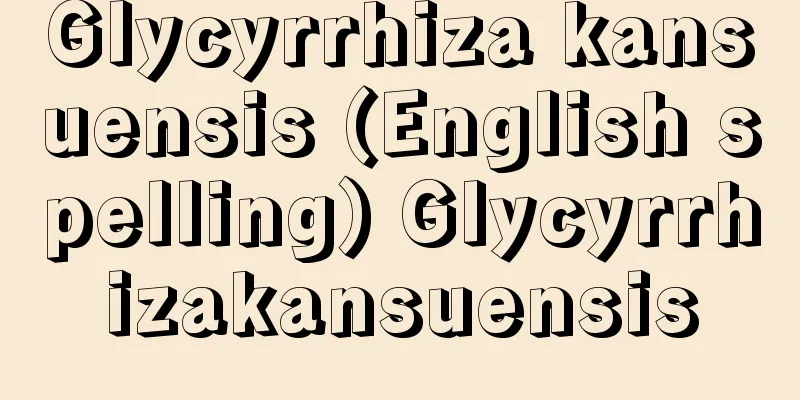Maypole

|
...The Kabbalistic tree was passed down to mystics from the Renaissance onwards, and became a symbol of the creation of the universe from a transcendental source. In addition, the European Maypole, the Navajo reed, and the Japanese Shinto sakaki are also symbols of the cosmic axis in which divinity resides, and the cross can be said to be one development of such central symbolism. From 【May Festival】...At that time, people believed that the spirits of trees brought rain and sunlight, made crops grow, and increased livestock. For this reason, they erected May trees or Maypoles on May 1st in order to receive the blessings of the spirits of trees that were resurrected in the spring, and celebrated May Day. This custom has remained in Europe, including England, France, and Germany, until recently, and in some places continues to this day. From [Tree Worship]...The idea that sacred groves are the dwelling place of gods and serve as places of worship is not unique to Japan, but can also be seen in the dawn of European history, when the lands were covered with vast primeval forests. The custom of cutting a tree from the forest and carrying it to the central square of the village during the Pentecost celebrations, known as the Maypole, is a vestige of this custom. In the Périgord region and elsewhere, it was called the Tree of Liberty and became a symbol of the French Revolution. The idea that gods, spirits, and deities reside in trees is widespread, and the Japanese folk custom of Narikizeme, in which people pray to the spirits of trees for fertility, corresponds to the custom of Bulgarian farmers swinging an axe at fruit trees that do not bear fruit on Christmas Eve. From [Pillar]… The custom of erecting a pillar at a festival site is seen all over the world. In Europe, during festivals to welcome May (spring), a Maypole is erected in a church or town square and people dance around it. In the Vedic sacrifices of India, a sacred pillar is erected on the altar, and the pillar is said to connect the sacred sacrifice as well as heaven and earth. … *Some of the terminology that mentions "Maypole" is listed below. Source | Heibonsha World Encyclopedia 2nd Edition | Information |
|
…このカバラの木は,ルネサンス以降の神秘主義者たちに受け継がれ,超越的源泉からの宇宙の生成の象徴図となった。 このほか,ヨーロッパのメーポールMaypole,ナバホ・インディアンのアシ,日本における神道のサカキも,そこに神性が宿る宇宙軸のシンボルの一種であり,十字架も,このような中心のシンボリズムの発展の一つであるといえよう。 【五月祭】より…当時,人々は樹木の霊魂が雨と太陽の光をもたらし,農作物を生育させ,家畜をふやすと信じていた。このため,彼らは春になってよみがえった樹木の霊魂の恩恵にあずかろうとして,5月1日に〈五月の樹〉や〈五月の柱Maypole〉を立て,五月祭を祝った。この習慣はイギリス,フランス,ドイツなどヨーロッパ各地に最近まで残り,所によっては今日まで続いている。… 【樹木崇拝】より…聖なる森が神の住居とされ,礼拝の場となる例は日本に限らず,大原始林に覆われたヨーロッパの歴史の黎明(れいめい)期にもみられた。聖霊降臨祭の行事に森から1本の木を切ってきて村の中央の広場に運ぶ〈五月の木(メーポールMaypole)〉の習俗が伴うのはその名残りで,ペリゴール地方ほかでは〈自由の木〉と呼び,フランス革命の象徴となった。樹木に神,神霊,精霊が宿るとする観念は広く見いだされ,樹霊に対して多産を祈る日本の〈成木責め(なりきぜめ)〉の民間習俗は,ブルガリア農民がクリスマス・イブに実をつけない果樹に斧を振っておどす習俗と対応している。… 【柱】より… 祭りの場に柱を立てる習俗は世界各地にみられる。ヨーロッパでは5月(春)を迎える祭りのとき,教会や町の広場にメーポールMaypole(五月柱)を立て,まわりを踊る。またインドのベーダにおける供犠では,祭壇に聖なる柱が立てられるが,その柱は聖なる犠牲をつなぐものであると同時に,天と地をつなぐものとされる。… ※「Maypole」について言及している用語解説の一部を掲載しています。 出典|株式会社平凡社世界大百科事典 第2版について | 情報 |
>>: Mayurasataka (English spelling)
Recommend
feature film
...It is also called a programmer in English. In ...
Prado Museum - Prado Museum (English name) Museo del Prado
Located in Madrid, the capital of Spain, this is ...
Free thinker - jiyushisoka (English spelling)
Generally speaking, it refers to thinkers who exa...
Ogasawara air mass
A tropical maritime air mass that appears in the ...
Mirafra javanica (English spelling)
…Of the 15 genera and 75 species, all of them and...
Club of Rome
This voluntary organization was formed by intellec...
Habutae
Also called plain silk, it is a post-refined fabr...
Color TV
〘Noun〙 (TV is an abbreviation of "television&...
Maastricht (English spelling)
The capital of the province of Limburg in the sout...
Excessive number - Kajousu
When the sum of the divisors (including 1) other t...
musk mallow
…It was introduced to Japan long ago during the E...
Bay of Fundy
A bay located between the southeastern sides of t...
Okunu
〘Noun〙 Hemp cloth produced in Mutsu Province. It i...
Nobuo Ayukawa
Poet. Born on August 23, 1920 in Koishikawa, Toky...
Kara Uthman - Kara Uthman
...Their royal lineage was from the Bayindur trib...









